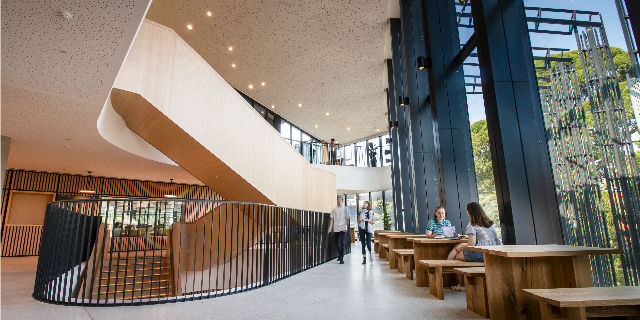Biomedicine precinct expands with opening of new life sciences complex
Thousands of biomedical sciences students are set to enjoy the new $100 million world-class facilities at Building 125, with doors opening on 25 March.
The University of Melbourne has strengthened the global status of the biomedical precinct with the opening of a life sciences complex, offering Australia’s most sophisticated STEMM teaching laboratories and facilities.
For the first time, the University will have staff and students from three faculties – Medicine, Dentistry and Health Sciences, Science and Veterinary and Agricultural Sciences – in one state-of-the-art building in Parkville.

The new complex underpins the University’s commitment to global excellence in life sciences teaching, learning, research and engagement, enabling a cross-disciplinary approach to teaching and learning.
More than 700 students a day in the Science, Technology, Engineering, Mathematics and Medicine fields will learn in the new four-level, 6-star Green Star building.

The complex includes:
- Three large practical teaching laboratories, including a 128-seat wet lab and active learning environment focused on biochemistry, molecular biology and pharmacology practicals
- An object-based learning facility
- Informal learning and study spaces dedicated to preparing the bioscientists, doctors and veterinarians of the future
- The latest sophisticated technologies to substantially improve the student and teacher experience.
Victorian Minister for Higher Education Gayle Tierney joined Vice-Chancellor Duncan Maskell to open the building, which included an Indigenous smoking ceremony.
“The building is a tremendous addition to the Melbourne Biomedical Precinct,” Professor Maskell said.
“The new complex allows the University of Melbourne to offer a premier teaching and learning experience and the best facilities in biosciences in our region. The building design, architecture and the resources available to students and lecturers is first class,”
“We will be able to grow our Faculty of Science, Faculty of Medicine, Dentistry and Health Sciences and Faculty of Veterinary and Agricultural Sciences and continue to attract the leading students and lecturers to make a real difference in the life sciences fields globally.”
Laureate Professor Peter Doherty added: “Diverse threads of the vast interrogation of nature we call science are coming together in a rich and mutually informative intellectual tapestry”.

A microscope image of horse cartilage has been used in the building facade as part of the facility’s innovative design.
Key features of the life sciences building:
- Three large practical teaching laboratories, an object-based learning facility, three classrooms for small group and problem-based learning and informal learning and study spaces
- The building sits beside the University’s System Garden which is a culturally important garden where plants are grouped together, dating back to the 1850’s
- The building includes rain water harvesting and re-use, landscape irrigation from rainwater, high efficiency fittings and fixtures
- Passive design initiatives include high performing glass facade, external shading and air tight construction, plus timber-lined walls and a sweeping timber staircase
- The complex has a solar power system producing 140,000 kWh of solar energy a year – offsetting the power usage for mechanical ventilation, fans, fume cupboards and lifts
- The complex was designed by Hassell and built by Kane Constructions.
Photography: Sarah Fisher/University of Melbourne